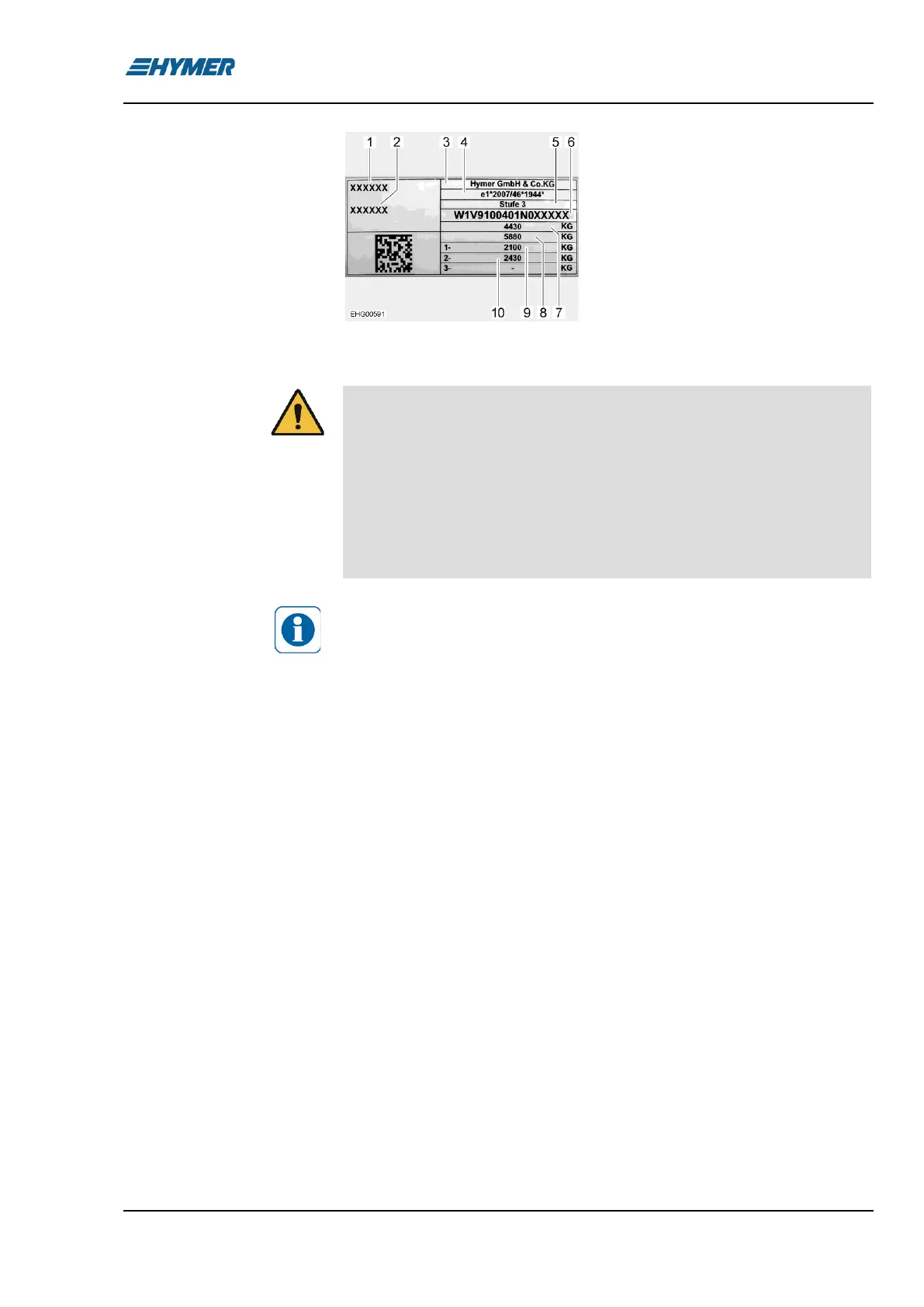Hymer Exsis I (2025) handleiding
Handleiding
Je bekijkt pagina 29 van 240

Before the journey 3
Exsis I/T - 01/23-1 - EHG-0027-02EN 29
1 Vehicle type
2 Consecutive serial number
3 Manufacturer
4 Vehicle type approval
5 Body stage
6 Chassis number
7 Technically permissible maximum
laden mass
8 Permissible total towing mass (with
caravan coupling option)
9 Technically permissible maximum
laden mass on axle 1
10 Technically permissible maximum
laden mass on axle 2
Fig. 2 Nameplate
If the technically permissible maximum laden mass on the axle is ex-
ceeded, the vehicle may be damaged (e.g. due to a broken axle or tire
blowout) and driving performance may be considerably impaired. This
may cause you to lose control of the vehicle, endangering yourself
and other road users. We therefore recommend weighing the final
loaded vehicle including all passengers before commencing travel in
order to ensure compliance with the mass on the axle and the techni-
cally permissible maximum laden mass at all times. For this purpose,
you can weigh/check the vehicle on public scales or have it weighed
by certain dealers.
Please note that the mass on the respective axles or axle groups may
differ. For this reason, please read the information provided in the regis-
tration papers carefully.
If you drive the vehicle even though it exceeds the technically permissi-
ble maximum laden mass on the axle specified by the manufacturer, you
may face legal consequences, such as a fine or loss of insurance.
It is possible that the chassis manufacturer of your vehicle specifies a
minimum load for the front axle in order to achieve optimum driving be-
havior. Therefore, please also always observe the information regarding
this from the operating instructions of the chassis manufacturer.
For further information on correct loading, please refer to the sections
"Load securing and load distribution" (page 26) and "Rear garage/rear
storage space" (page 32).
◼ Multiply the distance between storage space and front axle (A) with the
weight of the load in the storage space (G) and divide the result by the
wheelbase (R). The result is the weight of the load in the storage space
on the rear axle. Make a note of this weight and of the storage space.
◼ In a second step, subtract the weight in the storage space (G) from the
weight calculated beforehand. If the result is a positive value (exam-
ple 1), this means that the load on the front axle is reduced by this
value. If the result is a negative value (example 2), this means that the
load on the front axle is increased. Make a note of this value, too.
◼ Calculate all storage spaces of the vehicle in the same way.
◼ In a last step, add all weights calculated for the rear axle to the mass on
the rear axle and add (or subtract) all weights calculated for the front
axle to (from) the mass on the front axle.
How to determine the mass on the rear axle and front axle is described
in section 3.2.2.
Calculating masses on the
axles:
Bekijk gratis de handleiding van Hymer Exsis I (2025), stel vragen en lees de antwoorden op veelvoorkomende problemen, of gebruik onze assistent om sneller informatie in de handleiding te vinden of uitleg te krijgen over specifieke functies.
Productinformatie
| Merk | Hymer |
| Model | Exsis I (2025) |
| Categorie | Niet gecategoriseerd |
| Taal | Nederlands |
| Grootte | 25423 MB |


